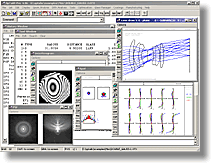Software for Optical Design, Thin-Films and Illumination: OpTaliX®
OpTaliX is a comprehensive program for computer aided design of optical systems, thin film multilayer coatings and illumination systems. OpTaliX provides powerful features to conceptualize, design, optimize, analyze, tolerance and document virtually any optical system.
OpTaliX is successfully used for the design of photographic and video lenses, industrial optics (beam expander, laser scanners, reproduction, machine vision), space optics, zoom optics, medical optics, illumination devices, fiber optical telecom systems, infrared optics, X-ray optics, telescopes, eyepieces, and many more.
OpTaliX includes geometrical and diffraction analysis, optimization, thin film multilayer analysis and refinement, non-sequential ray trace, physical optics propagation, polarization analysis, ghost imaging, tolerance analysis, extensive manufacturing support, user defined graphics, illumination, macros, and many more.


OpTaliX is tested and certified for Win-XP, Win-7, Win-Vista, Win-8, Win-10, for both 32-bit and 64-bit operating systems. OpTaliX is available in three editions, called OpTaliX-Pro, OpTaliX-Edu and OpTaliX-LT.
OpTaliX supports multiple processor architectures in 32-bit and 64-bit editions from OpTaliX version 8.xx onwards:

Version 11.21 Update: (18-Oct-2021)
- The parameter xsc,ysc,zsc and xsg,ysg,zsg now work for all zoom positions, and not for the first position, as done previously.
- Stability of MTF vs. defocus has been improved on multi-processor systems.
- SCO command corrected to accept entry of multiple coefficients, e.g. SCO ci..j correctly assigns the coefficients according to the surface type.
- Polarization and transmission calculation in non-sequential environment activated.
- Import/export from/to Zemax now supports the BINARY_2 surface type.
- Inverse raytrace corrected at surfaces which are both aspheric and tilted.
- Melt/private glasses: This option now allows up to 2000 wavelength/index data pairs to generate the glass dispersion coefficients. Previously, only 100 data pairs were allowed.
- Minor changes.
Download update version 11.21
